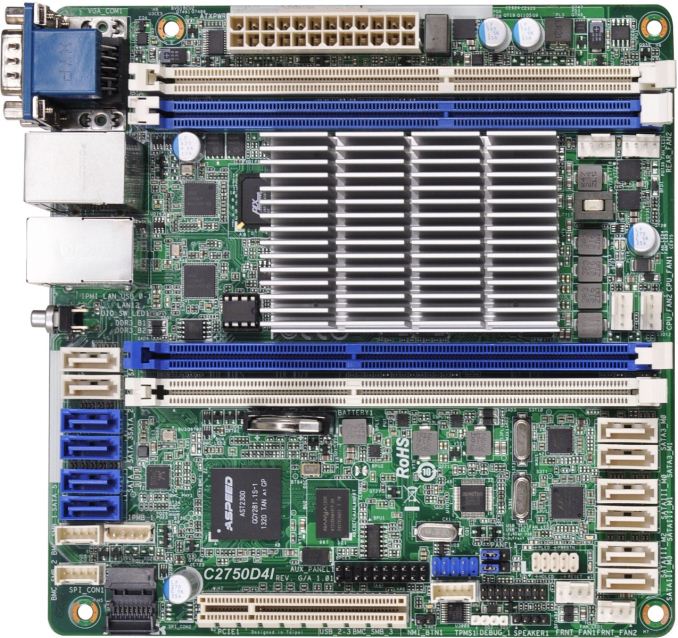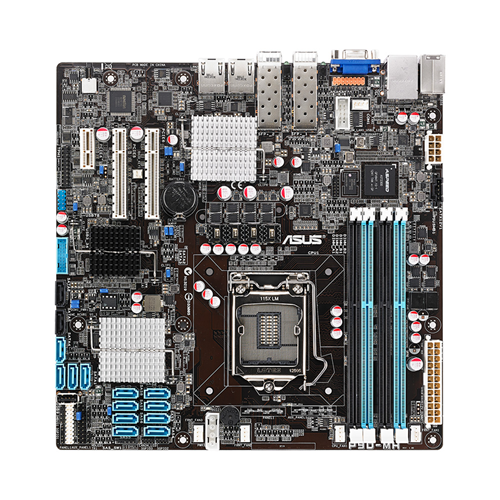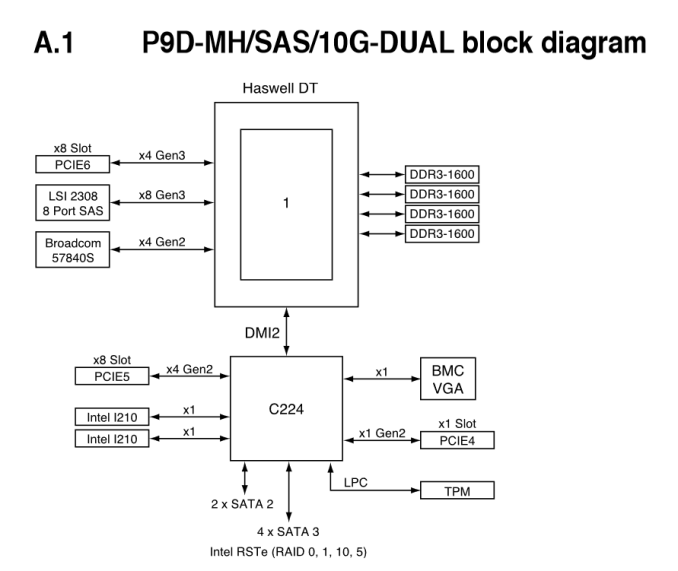X-Gene 1, Atom C2000 and Xeon E3: Exploring the Scale-Out Server World
by Johan De Gelas on March 9, 2015 2:00 PM ESTLow-End Server Building Blocks
Micro and low-end servers come in all shapes and forms. Ideally, we would gather them all in our labs and make a performance per watt comparison, taking the features that make management easier into account. The reality is that while lots of servers enter our lab, many of the vendors cannot be easily convinced to ship heavy and expensive server chassis with a few tens of nodes.
In AnandTech tradition, we decided to take a look at the component level instead. By testing simple motherboard/CPU/RAM setups and then combining those measurements with the ones we get from a full blown server, we can get a more complete picture. A simple motherboard/CPU/RAM setup allows us the lowest power numbers possible, and a full blown server measurement tells us how much the more reliable cooling of a full blown server chassis adds.
ASRock's C2750D4I
The mini-ITX ASRock C2750D4I has the Atom "Avoton" C2750 SoC (2.4GHz, eight Silvermont cores) on board. If you are interested in using this board at home, Ian reviewed it in great detail. I'll focus on the server side of this board and use it to find out how well the C2750 stacks up as a server SoC.
Contrary to the Xeon E3, 16GB DIMMs are supported. The dual-channel, four DIMM slot configuration allows you to use up to 64GB. This board is clearly targeted at the NAS market, as ASRock not only made use of the six built-in SATA ports (2x SATA 6G, 4x SATA 3G) of the Atom SoC but also added a Marvell SE9172 (2x SATA 6G) and a Marvell SE9230 (4x SATA 6G) controller. Furthermore, ASRock soldered two Intel i210 gigabit chips and an AST2300 to the board. However, the Atom "Avoton" integrated 16 PCIe lanes only support four PCIe devices. The PCIe x8 slot already needs eight of them and the Marvel SE9230 takes another two PCIe lanes, so the ASRock board needs a PLX 8608 PCIEe switch.
The end result is that the ASRock C2750 board consumes more energy at idle than a simpler micro server board would. We could not get under 26W, and with four DIMMs 31W was needed. That is quite high, as Supermicro and several independent reviews report that the Supermicro A1SAM-2750F needs about 17W in the same configurations.
ASUS P9D-MH
The micro-ATX ASUS P9D-MH is a feature rich Xeon E3 based board. ASUS targets cloud computing, big data, and other network intensive applications. The main distinguishing feature is of course the dual 10 Gigabit SFP+ connectors of the Broadcom 57840S controller.
The C224 chipset provides two SATA 3G ports and four SATA 6G ports. ASUS added the LSI 2308 controller to offer eight SAS ports. The SAS drives can be configured to run in a RAID 0/1/10 setup.
The Xeon E3-1200v3 has 16 integrated PCIe 3.0 lanes. Eight of them are used by the LSI 2308 SAS controller, and the 10 Gigabit Ethernet controller gets four fast lanes to the CPU. That leaves four PCIe 3.0 lanes for a mechanical x8 PCIe slot.
The second x8 PCIe slot gets four PCIe 2.0 slots and connects to the C224 chipset. The remaining PCIe 2.0 lanes are used by the BMC, the PCIe x1 slot, and the dual gigabit Ethernet controller.
Of course, all these features come with a price. With the efficient Xeon E3-1230L (25W TDP) and four 8GB DIMMs, the board consumes 41W at idle.













47 Comments
View All Comments
JohanAnandtech - Tuesday, March 10, 2015 - link
Are you sure this is up to date? gcc tells me -march=native is not supported.JohanAnandtech - Tuesday, March 10, 2015 - link
Update. march=native does not work. I have tried -march=armv8-a but does not do much (it is probably the default). O3 makes the biggest difference. Omit it and you get 5.7 GB/s. With -O3, I am at 18 GB/s and more (stream m400)Alone-in-the-net - Tuesday, March 10, 2015 - link
Apologies. For AArch64 the only is "armv8-a", for intel, -march=native sets it to use the one for your CPU.https://gcc.gnu.org/onlinedocs/gcc-4.8.2/gcc/AArch...
https://gcc.gnu.org/onlinedocs/gcc-4.8.2/gcc/i386-...
From version 4.9.x and above of GCC, you can really start to add tuning for the CPU.
https://gcc.gnu.org/onlinedocs/gcc-4.9.2/gcc/AArch...
-mtune=name
Specify the name of the target processor for which GCC should tune the performance of the code. Permissible values for this option are: ‘generic’, ‘cortex-a53’, ‘cortex-a57’.
Additionally, this option can specify that GCC should tune the performance of the code for a big.LITTLE system. The only permissible value is ‘cortex-a57.cortex-a53’.
Where none of -mtune=, -mcpu= or -march= are specified, the code will be tuned to perform well across a range of target processors.
Alone-in-the-net - Tuesday, March 10, 2015 - link
Also support for the XGene1 as a compilation target is only from GCC5.https://gcc.gnu.org/gcc-5/changes.html
Support has been added for the following processors (GCC identifiers in parentheses): ARM Cortex-A72 (cortex-a72) and initial support for its big.LITTLE combination with the ARM Cortex-A53 (cortex-a72.cortex-a53), Cavium ThunderX (thunderx), Applied Micro X-Gene 1 (xgene1). The GCC identifiers can be used as arguments to the -mcpu or -mtune options, for example: -mcpu=xgene1
The_Assimilator - Monday, March 9, 2015 - link
So AMD, how's that bet on ARM you made looking now?extide - Monday, March 9, 2015 - link
Don't count them out yet. I really wish that intel didn't abandon ARM for the Atom, I bet they could come out with a sweet armv8 core if they had to, and on their process it would be sweet.BlueBlazer - Monday, March 9, 2015 - link
That AMD Opteron A1100 looking more like abandonware as more time passes on, and that was like 8 months ago. Until now not a single real world deployment nor was used in any of AMD's own SeaMicro servers. Currently available as development kit with a rather steep price tag.tuxRoller - Monday, March 9, 2015 - link
You REALLY should be using GCC 5. that includes many improvements for the armv8 isa. I'd suggest grabbing a nightly of Fedora 22, but Ubuntu 15.04 may be using gcc5 as well.Wilco1 - Monday, March 9, 2015 - link
Agreed, nobody doing anything on AArch64 should contemplate using GCC4.8. Even 4.9 is way out of date. GCC5.0 with latest GLIBC gives major speedups across the board.JohanAnandtech - Tuesday, March 10, 2015 - link
"Way out of date?" We tried out 4.9.2, which has been released on October 30th 2014. That is about 4 months old. https://www.gnu.org/software/gcc/releases.html. Latest version is 4.8.4, 5.0 has not even been released AFAIK.